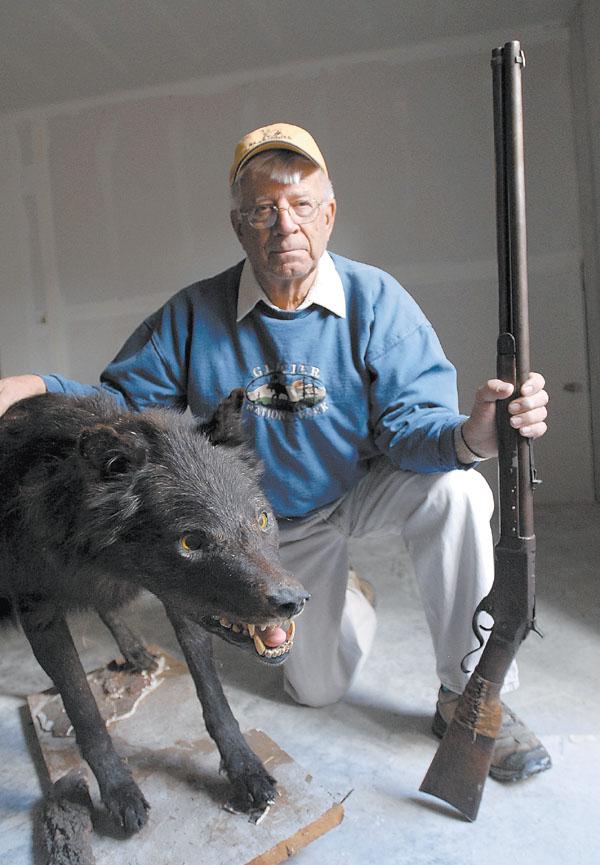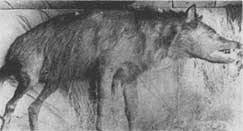
Posted on 11/15/2007 2:27:42 PM PST by BGHater
ENNIS - More than a century ago, a wolf-like creature prowled the Madison Valley, killing livestock and letting out screams that one account said would leave a person's hair standing on end.
A bullet from a Mormon settler's rifle ended the animal's life and triggered stories of the creature that were passed along through generations of family history and local folklore.
The only evidence of the creature's existence was a missing taxidermy mount and a grainy black-and-white photograph of that mount - which fueled strange speculation about what kind of animal it really was.
Now after 121 years, the taxidermy mount has been found. The creature that once spooked some of the Madison Valley's first white settlers has come home.
“I never doubted the story,” said Jack Kirby, grandson of the settler who shot the animal.
After reading a Halloween-themed Chronicle story about local legends of strange creatures, Kirby tracked down the mount in the Idaho Museum of Natural History in Pocatello.
The museum has since loaned it to him to put on display at the Madison Valley History Museum, although at the moment it resides in the basement of a building on the north edge of town.
The “ringdocus” or “shunka warak'in” - two of the names it has been given over the years - strongly resembles a wolf, but sports a hyena-like sloping back and an odd-shaped head with a narrow snout. Its coat is dark-brown, almost black, with lighter tan areas and a faint impression of stripes on its side.
It measure 48 inches from the tip of its snout to its rump, not including the tail, and stands from 27 to 28 inches high at the shoulder.
The mount is in amazingly good shape, showing no signs of wear and tear and retaining the color of the fur. It arrived in Ennis Friday.
One of its first stops was the gravesite of the man who shot it, Israel Ammon (I.A.) Hutchins.
“We took him down to the cemetery to see I.A. to let him know (the creature) is back in the valley,” said Kirby's wife, Barbara.
Hutchins shot the animal in 1886 on what is now the Sun Ranch, but not on his first try. He accidentally shot and killed one of his cows when he first spotted the creature on his land, his son Elliott Hutchins recounted in his memoirs.
He killed the strange animal when it appeared on his land a second time and traded the body with entrepreneur Joseph Sherwood for a new cow.
Sherwood was a taxidermist. He mounted the animal and put it on display in his combination store-museum at Henry's Lake in Idaho. His taxidermy collection was later given to the Idaho Museum of Natural History, where it was kept in storage.
The creature apparently baffled the people who saw it alive, and some speculated it was a hyena escaped from a circus rather than a wolf. The younger Hutchins remembered its haunting screams at night and wrote that after it was shot and in its death throes, the animal bit through a half-inch rope with a single bite and “exerted his very last strength to reach any one of us.”
The story of the “ringdocus” - as Sherwood reportedly named it - reached a national audience when the prolific writer and naturalist Ross Hutchins wrote about it in his 1977 autobiography, “Trails to Nature's Mysteries: The Life of a Working Naturalist,” and included a picture of the mount. I.A. Hutchins was his grandfather.
The tale was again picked up by writers Loren Coleman and Jerome Clark in their book “Cryptozoology A to Z.” In that book, Coleman linked it to a Native American legend about the “shunka warak'in,” a creature that snuck into camps at night to steal dogs.
The animal has so far eluded identification. The younger Hutchins wrote that a detailed description was sent to the Smithsonian Institution, which wasn't able to identify it.
The picture of the mount included the scientific-sounding name “Guyasticutus” as a label for the creature, but the name may have been tongue-in-cheek. Early accounts report that the Guyasticutus was a mythical creature invented by traveling showmen to swindle gullible ticket-buyers.
Coleman and Clark suggested that a DNA test should be done on the mount to determine what it is. Kirby, however, was not so certain he was ready to end a mystery that had been passed down by his family for four generations.
“Do we want to know?” he said.
The mount will be displayed in the Madison Valley History Museum when it reopens in May.
Walt Williams is at wwilliams@dailychronicle.com or 582-2630.


Tasmanian Devil. The body build, some aspects of the coloration. Oddly similar.
PING!!!
“Now after 121 years, the taxidermy mount has been found. “
This has always bothered me about state run museums. That phrase “has been found.”
My friend was a curator of oriental art at a state museum. He took me to the backroom where there were drawer after drawer, and case after case, stacked to the ceiling, of oriental artifacts that couldn’t be displayed because of lack of display space in the oriental art section.
Some of the artifacts were crumbling from age and lack of proper climate control.
Artifacts like these need to be auctioned off to private collectors where they will be cared for.

I was thinking Tasmanian something too. Didnt they have a striped wolflike animal? This looks bigger than the Tasmanian Devil to me.
“Thylacine” or “Tasmanian Tiger,” not “Tasmanian Devil,” although I know what you mean because I had the same reaction. But Thylacines’ hindquarters are higher than the withers.
I suspect it’s really a variant Jackalope.
Also in the 60's, in Oakland, CA, a man called police to report that a pig had fallen into his swimming pool.
They came out, along with animal control; looked, and told him that it wasn't a pig; it was a baby hippo.
He told them, "I know that, but if I called and said there was a hippopotamus in my pool, you wouldn't have come."
More specifically, jackalope bucks. Shunka warak’ini clearly werent built for speed but they didnt need it. Jackalope bucks are so territorial and protective of their harems that they charge anything entering their territory with their antlers. In fact, thats why jackalopes are endangered (especially the rare "cedar shoe"). When the rail was first run through the plains, the jackalope bucks charged the steam engines. From the Appalachians to the Rockies they run under the engines one after another, and thats why the tie beds are so deep in some areas.
When the jackalope population was no longer plentiful enough to feed the species, the age of the Shunka warak’ini came to an end.
The white man destroyed and only the Democrats care enough to save.
Its too late for the Shunka warak’ini but you can still save the jackalope.
You forget the specific reference.
A WHITNEY KENNEDY RIFLE! WOW! Now that is rare! Tell us more of the history of this rifle!
WOW! A live Fiji mermaid!
Good shooting!
It isn’t a Dire Wolf is it?
|
|
|||
Gods |
Thanks pcottraux. |
||
|
· Mirabilis · Texas AM Anthropology News · Yahoo Anthro & Archaeo · · History or Science & Nature Podcasts · Excerpt, or Link only? · cgk's list of ping lists · |
|||
Deformed wolf
No, this one is crooked. The Dire’s straights.
Not a Tasmanina devil. Goggle it, they have photos of them before they were wiped out by idiots in Tasmania.
The hardest thing to swallow about these cryptozoological stories is that in order for an unknwon species to exist, it needs a large enough breeding colony to sustain genetic diversity. The larger the critter, the larger the range it needs to occupy, and in today’s shrinking world, the less likely such a large critter could possibly go unnoticed.
The idea of an unknown species population existing before the closing of the West and densified settlements is completely believable. The enviro-lefties rave all the time about lost plant species but a native Dingo/Hyena-like creature is even more believable.
Disclaimer: Opinions posted on Free Republic are those of the individual posters and do not necessarily represent the opinion of Free Republic or its management. All materials posted herein are protected by copyright law and the exemption for fair use of copyrighted works.